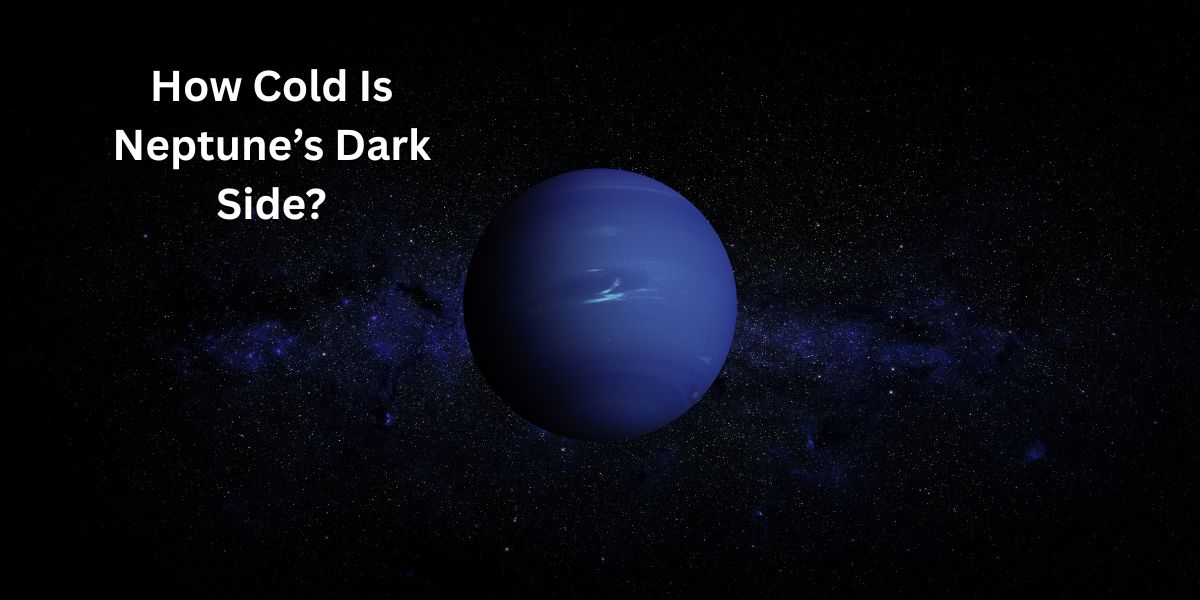Neptune is the farthest planet from the Sun in our solar system. It is a dark, windy, and very cold world. Unlike Earth, Neptune does not get much warmth from the Sun. Because of this, temperatures there are freezing!
But did you know Neptune has a “dark side”? Just like Earth has day and night, Neptune also has a side that faces away from the Sun. This side is even colder than the rest of the planet. Scientists have studied Neptune’s dark side and found some surprising facts.
So, how cold is Neptune’s dark side? Let’s find out!
How Far Is Neptune from the Sun
Neptune is the eighth planet from the Sun. It is so far away that sunlight takes about 4 hours to reach it! On Earth, sunlight reaches us in just 8 minutes.
Because Neptune is so distant, it gets very little heat. The Sun looks like a tiny bright star from there. This is one reason why Neptune is so cold.
Fun Fact:
- If you could stand on Neptune (which you can’t, because it’s a gas giant), the Sun would look 900 times dimmer than it does on Earth!
What Is Neptune’s Dark Side?
Like all planets, Neptune rotates, which means it has a day and night cycle. The side facing away from the Sun is called the “dark side.”
Since Neptune takes about 16 hours to complete one rotation, its dark side stays cold for a long time. Without sunlight, temperatures drop even lower than usual.
Comparison:
- Earth’s dark side (nighttime) cools down, but not as much as Neptune’s because our planet is much closer to the Sun.
How Cold Is Neptune’s Dark Side?
Neptune is already one of the coldest planets. The average temperature is around -353°F (-214°C). But its dark side gets even colder!
Scientists believe the dark side can drop below -364°F (-220°C). That’s colder than Antarctica’s coldest day!
Why So Cold?
- No sunlight reaches the dark side.
- Neptune’s thick atmosphere traps some heat, but not enough to keep the dark side warm.
Does Neptune Have Seasons?
Yes! Neptune has seasons, just like Earth. But since one Neptune year lasts 165 Earth years, each season lasts for decades!
During winter, parts of Neptune get even colder. The dark side in winter could be the coldest place on the planet.
Fun Fact:
- Neptune’s summer is still freezing because the Sun is too far away to warm it up much.
What Makes Neptune So Windy?
Neptune has the strongest winds in the solar system—up to 1,200 mph (1,930 km/h)! These winds make the planet even colder because they spread the cold air around.
Even on the dark side, these winds keep moving, making the temperature feel even more extreme.
Comparison:
- The fastest winds on Earth (in tornadoes) reach about 300 mph (480 km/h)—much slower than Neptune’s winds!
Could Humans Ever Visit Neptune?
No, humans cannot visit Neptune—at least not now. The planet is made of gas, so there’s no solid ground to stand on. Also, the extreme cold, crushing pressure, and deadly winds would make survival impossible.
Robots and space probes, like Voyager 2, have flown by Neptune and sent back pictures. But even machines would struggle to survive for long in such harsh conditions.
Conclusion
Neptune’s dark side is one of the coldest places in our solar system. With temperatures dropping below -364°F (-220°C), it’s even colder than the rest of this icy planet. The lack of sunlight, extreme winds, and great distance from the Sun make Neptune a freezing, stormy world.
Is Neptune colder than Pluto?
No, Pluto is colder than Neptune. Pluto’s average temperature is around -387°F (-233°C), while Neptune’s is about -353°F (-214°C).
Why is Neptune blue?
Neptune’s blue color comes from methane gas in its atmosphere. Methane absorbs red light and reflects blue light, making the planet look blue.
How long is a day on Neptune?
A day on Neptune lasts about 16 hours. It rotates faster than Earth, where a day is 24 hours.
Does Neptune have rings?
Yes, Neptune has five main rings. They are faint and made of dust and ice, unlike Saturn’s bright rings.
Has any spacecraft visited Neptune?
Only one spacecraft, Voyager 2, has flown by Neptune (in 1989). It took the first close-up photos of the planet.
What is Neptune made of?
Neptune is a gas giant made mostly of hydrogen, helium, and methane. It has a small rocky core deep inside.
Can it rain diamonds on Neptune?
Scientists believe Neptune’s pressure could turn methane into diamonds that “rain” inside the planet. But no one has seen this happen!
How many moons does Neptune have?
Neptune has 14 known moons. The largest one, Triton, is even colder than Neptune itself!
Why is Neptune called the “windy planet”?
Neptune has the fastest winds in the solar system, reaching up to 1,200 mph (1,930 km/h).
Will Neptune ever be warm?
No, Neptune will always be cold because it is too far from the Sun. Even its “summer” is freezing!
